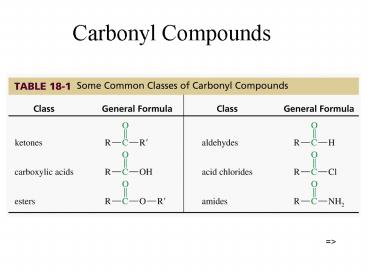Carbonyl Compounds - PowerPoint PPT Presentation
1 / 23
Title:
Carbonyl Compounds
Description:
Indicate the position of the carbonyl with a number. Number the chain so that carbonyl ... 1 C: formic acid, formaldehyde. 2 C's: acetic acid, acetaldehyde ... – PowerPoint PPT presentation
Number of Views:156
Avg rating:3.0/5.0
Title: Carbonyl Compounds
1
Carbonyl Compounds
gt
2
IUPAC Names for Ketones
- Replace -e with -one. Indicate the position of
the carbonyl with a number. - Number the chain so that carbonyl carbon has the
lowest number. - For cyclic ketones the carbonyl carbon is
assigned the number 1.
3
Examples
3-methyl-2-butanone
3-bromocyclohexanone
4-hydroxy-3-methyl-2-butanone
4
Naming Aldehydes
- IUPAC Replace -e with -al.
- The aldehyde carbon is number 1.
-
5
Examples
3-methylpentanal
6
Common Names for Ketones
- Named as alkyl attachments to -CO.
- Use Greek letters instead of numbers.
methyl isopropyl ketone
a-bromoethyl isopropyl ketone
7
Historical Common Names
acetophenone
acetone
benzophenone
8
Aldehyde Common Names
- Use the common name of the acid.
- Drop -ic acid and add -aldehyde.
- 1 C formic acid, formaldehyde
- 2 Cs acetic acid, acetaldehyde
- 3 Cs propionic acid, propionaldehyde
- 4 Cs butyric acid, butyraldehyde.
9
Name the following
2,4-dimethyl-3-hexanone
2-methylcycloheptanone
2-propanone
butanal
acetone
butyraldehyde
10
IR Spectroscopy
- Very strong CO stretch around 1710 cm-1.
- Conjugation lowers frequency.
- Ring strain raises frequency.
- Additional C-H stretch for aldehyde two
absorptions at 2710 cm-1 and 2810 cm-1.
11
(No Transcript)
12
How can you tell the difference between the
following compounds by their IR spectra?
13
(No Transcript)
14
Esters are higher frequency
Amides are lower frequency
15
H NMR
16
1H NMR Spectroscopy
gt
17
13C NMR Spectroscopy
gt
18
MS for 2-Butanone
gt
19
Provide the structure of the diethyl acetal of
butanal.
20
Propose a sequence of steps to carry out the
following conversion.
21
When the following compound is heated in the
prosence of an acid catalyst, a reaction occurs.
The product has the formula C6H11N. Provide the
structure of this product.
22
When the following compound is heated in the
presence of an acid catalyst, a reaction occurs.
This product has the formula C9H16O2. Provide the
structure of this product.
23
Which of the following is also known as a Schiff
base? a) an imine b) a cyanohydrin c) a
hydrate d) sodium hydroxide e) an aldehyde
A































